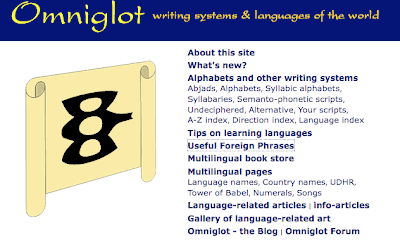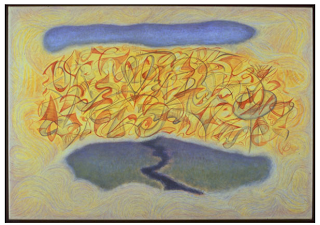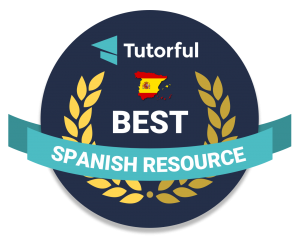
I came across Omniglot the other day and bookmarked it in my del.icio.us account for further investigation.
Omniglot is ‘a guide to the languages, alphabets, syllabaries and other writing systems of the world’.
You can find out information about a myraid of languages including ones I’ve never heard of!
It’s fascinating to look at all the different writing systems both real – some Mayanscript

and some imaginary – some Klingon!

There are tips on language learning, as well as a multilingual bookstore and articles on languages.
In fact, there’s so much on there that it’s hard to do it justice in a blogpost so I’d encourage you to look for yourself. However, here are three of my favourite parts.
1. Language related art
This is a piece of art by Venantius Pinto based on the Torcharian script and there are links to other examples of artwork such as Mike O’Connell‘s artwork featuring a number of different scripts and Peggy Shearn who is inspired by language and writing systems (see also below)
and there are links to other examples of artwork such as Mike O’Connell‘s artwork featuring a number of different scripts and Peggy Shearn who is inspired by language and writing systems (see also below)

2. Useful foreign phrases
Ever wanted to know how to say ‘Please speak more slowly’ in Estonian?
Or ‘Where’s the toilet?’ if you’re caught short in Greece?
??? ????? ?? ?????????
There is a quite long list of possible phrases in a wide range of languages – some with accompanying soundfiles to aid pronunciation. And there are also phrases that are possibly not as useful, but nonetheless amusing such as ‘My hovercraft is full of eels’ – here in Mandarin Chinese ?????????? and Polish Mój poduszkowiec jest pe?en w?gorzy and ‘Stop the world, I want to get off!’ in perhaps Czech Zastavte sv?t, chci vystoupit! or Armenian ??????? ?????? ????????, ??? ?????? ????:
You can also access in a variety of languages, again some with soundfiles-
for example –
??? ????? ?? ???? ?????;
(Miá pápia ma piá pápia)
A duck but which duck). (GREEK)
Esel essen Nesseln nicht, Nesseln essen Esel nicht.
Donkeys don’t eat nettles, and nettles don’t eat donkeys. (GERMAN)
Mae Llewellyn y llyfrgellydd o Lanelli wedi llyfu llawer o lyfaint.
Llewellyn, the librarian from Llanelli, licked many toads. (WELSH)
3.Proverbs and quotations about languages.
Omniglot has collected together proverbs and quotations in various tongues on the subject of languages. The majority are quite profound –
Language is the blood of the soul into which thoughts run and out of which they grow.
– Oliver Wendell Holmes
Una lengua natural es el archivo adonde han ido a parar las experiencias, saberes y creencias de una comunidad.
A natural language is the archive where the experiences, knowledge and beliefs of a community are stored.
– Fernando Lázaro Carreter (SPANISH)
Cenedl heb iaith, cenedl heb galon.
A nation without a language is a nation without a heart. (WELSH)
but there are others that are less ‘serious’ –
Chan fhiach cuirm gun a còmhradh.
A feast is no use without good talk. (GAELIC-SCOTLAND)
It’s no coincidence that in no known language does the phrase “As pretty as an airport” appear.
– Douglas Adams
??????????????????
(Ti?n bù pà, dì bù pà, zh? pà Gu?ngd?ng rén shu? P?t?nghuà)
I fear neither heaven nor earth, I only fear Cantonese speakers trying to speak Mandarin. (MANDARIN)
????????????????????
(Tìn m? gìng, deih m? gìng, jí gìng b?kfòng yàhn góng Gwóngdùngwá m?jeng)
I fear neither heaven nor earth, I only fear Mandarin speakers speaking Cantonese badly. (CANTONESE)
My particular favourites include
Any time you think some other language is strange, remember that yours is just as strange, you’re just used to it.
Kolik jazyk? znáš, tolikrát jsi ?lov?kem.
You live a new life f
or every new language you speak.
If you know only one language, you live only once. (Czech)
and this French saying that I hope will soon be seen as untrue –
Un homme qui parle trois langues est trilingue.
Un homme qui parle deux langues est bilingue.
Un homme qui ne parle qu’une langue est anglais.
A man who speaks three language is trilingual.
A man who speaks two languages is bilingual.
A man who speaks only one language is English.
– Claude Gagnière
Looking at all the above ‘favourites’ I can see the OMNIGLOT site as an excellent resource for expanding the vision of languages in an interesting and fun way.
Why not use it as a resource for European Day of Languages on 26th September?
You could use the artwork to inspire your pupils to create their own having looked at the section on various scripts and writing systems.
Or challenge pupils to learn tongue twister in another language – the sound files are great for that!
Or each class could attempt to learn a phrase in as many languages as possible – and other classes could guess the phrase – I think we’ll be doing this at WCPS!
Whatever you do, it’s well worth a look!

















